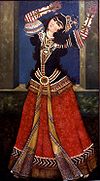
Back ثقافة فارسية Arabic İran mədəniyyəti Azerbaijani ইরানের সংস্কৃতি Bengali/Bangla Cultura de l'Iran Catalan Kulturê İrani DIQ Cultura de Irán Spanish فرهنگ ایرانی Persian Culture de l'Iran French ईरान की संस्कृति Hindi Իրանական մշակույթ Armenian
| Part of a series on the |
| Culture of Iran |
|---|
 |
|
|
The culture of Iran (Persian: فرهنگ ایران) or culture of Persia[1][2][3] is among the most influential in the world. Iran (Persia) is widely considered to be one of the cradles of civilization.[4][5][6][7] Due to its dominant geopolitical position in the world, it has heavily influenced peoples and cultures situated as far away as Southern Europe and Eastern Europe to the west; Central Asia to the north; the Arabian Peninsula to the south; and South Asia, East Asia, and Southeast Asia to the east.[4][5][8] Iranian history has had a significant influence on the world through art, architecture, poetry, science and technology, medicine, philosophy, and engineering.
An eclectic cultural elasticity has been said to be one of the key defining characteristics of the Iranian identity and a clue to its historical longevity.[9] Richard N. Frye, a prominent Iranologist, stresses the high-level historical influence of the Iranian culture in his 2005 book Greater Iran: A 20th-century Odyssey:
- "Iran's glory has always been its culture."[10]
Furthermore, Iran's culture has manifested itself in several facets throughout the history of the Iranian Plateau as well as of the South Caucasus, Central Asia, Anatolia, and Mesopotamia.
- ^ "Cultural Life". Tehrān. Encyclopædia Britannica. Retrieved 16 April 2018.
Persian cuisine is characterized by the use of lime and saffron, the blend of meats with fruits and nuts, a unique way of cooking rice, and Iranian hospitality. Food is delicate in flavour and appearance, heavy in meat, dairy, and herbs, and not hot or spicy. An emphasis on sour and sweet is found within this cuisine. Many recipes date back to ancient times; Iran's historical contacts have assisted in the exchange of ingredients, flavours, textures, and styles with various cultures ranging from the Mediterranean Sea region to China, some of whom retain these influences today.
- ^ Clark, Melissa (19 April 2016). "Persian Cuisine, Fragrant and Rich With Symbolism". The New York Times.
- ^ Yarshater, Ehsan Persia or Iran, Persian or Farsi Archived 2010-10-24 at the Wayback Machine, Iranian Studies, vol. XXII no. 1 (1989)
- ^ a b Oelze, Sabine (13 April 2017). "How Iran became a cradle of civilization". DW. Retrieved 3 July 2019.
- ^ a b Bakhtiyar, Afshin (2014). Iran the Cradle of Civilization. Gooya House of Cultural Art. ISBN 978-9647610032.
- ^ "Iran – Cradle of Civilisation". Drents Museum. 12 April 2018. Retrieved 3 July 2019.
- ^ Kermanshah, A Cradle of Civilization, 28 September 2007. Retrieved 4 July 2019
- ^ "Persian Influence on Greek Culture". Livius.org. 7 November 2018. Retrieved 3 July 2019.
- ^ Milani, A. Lost Wisdom. 2004.ISBN 0-934211-90-6 p.15
- ^ Greater Iran, Mazda Publishers, 2005. ISBN 1568591772 xi
© MMXXIII Rich X Search. We shall prevail. All rights reserved. Rich X Search